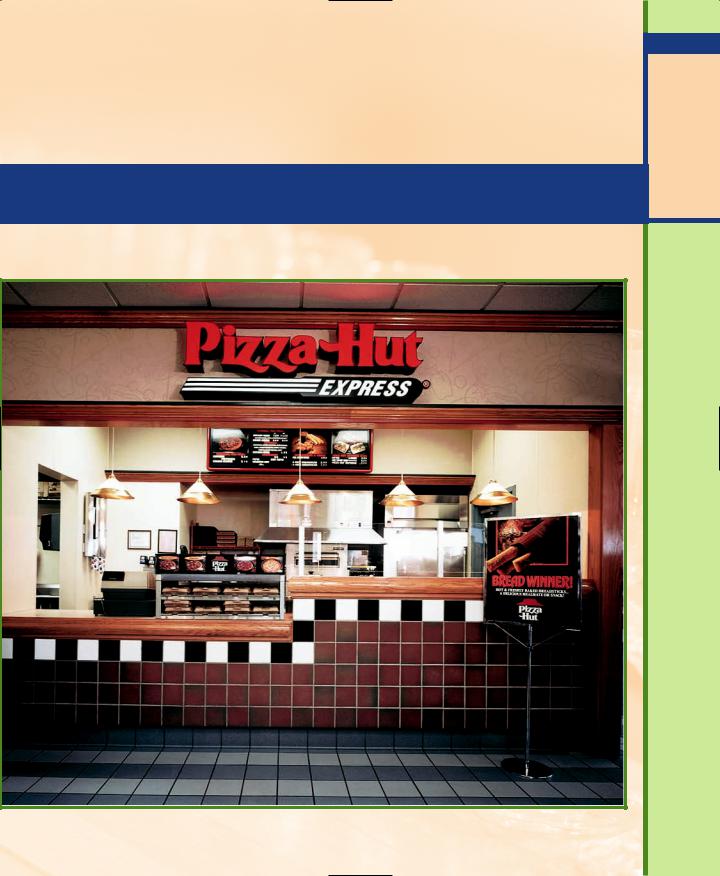
- •CONTENTS
- •PREFACE
- •Content—Benefits for Students
- •Content—Benefits for Instructors
- •Features of the Book for Students and Instructors
- •Supplementary Materials
- •Acknowledgments
- •What Is Hospitality Management?
- •The Manager’s Role in the Hospitality Industry
- •Why Study in a Hospitality Management Program?
- •Planning a Career
- •Employment as an Important Part of Your Education
- •Getting a Job
- •Employment at Graduation
- •The Outlook for Hospitality
- •Summary
- •Managing Change
- •Demand
- •Supply
- •Workforce Diversity
- •The Impact of Labor Scarcity
- •Summary
- •The Varied Field of Food Service
- •The Restaurant Business
- •The Dining Market and the Eating Market
- •Contemporary Popular-Priced Restaurants
- •Restaurants as Part of a Larger Business
- •Summary
- •Restaurant Operations
- •Making a Profit in Food Service Operations
- •Life in the Restaurant Business
- •Summary
- •Chain Restaurant Systems
- •Independent Restaurants
- •Franchised Restaurants
- •Summary
- •Competitive Conditions in Food Service
- •The Marketing Mix
- •Competition with Other Industries
- •Summary
- •Self-Operated Facilities
- •Managed-Services Companies
- •Business and Industry Food Service
- •College and University Food Service
- •Health Care Food Service
- •School and Community Food Service
- •Other Segments
- •Vending
- •Summary
- •Consumer Concerns
- •Food Service and the Environment
- •Technology
- •Summary
- •The Evolution of Lodging
- •Classifications of Hotel Properties
- •Types of Travelers
- •Anticipating Guest Needs in Providing Hospitality Service
- •Service, Service, Service
- •Summary
- •Major Functional Departments
- •The Rooms Side of the House
- •Hotel Food and Beverage Operations
- •Staff and Support Departments
- •Income and Expense Patterns and Control
- •Entry Ports and Careers
- •Summary
- •The Economics of the Hotel Business
- •Dimensions of the Hotel Investment Decision
- •Summary
- •The Conditions of Competition
- •The Marketing Mix in Lodging
- •Product in a Segmented Market
- •Price and Pricing Tactics
- •Place—and Places
- •Promotion: Marketing Communication
- •Summary
- •The Importance of Tourism
- •Travel Trends
- •The Economic Significance of Tourism
- •The United States as an International Tourist Attraction
- •Businesses Serving the Traveler
- •Noneconomic Effects of Tourism
- •Summary
- •Motives and Destinations
- •Mass-Market Tourism
- •Planned Play Environments
- •Casinos and Gaming
- •Urban Entertainment Centers
- •Temporary Attractions: Fairs and Festivals
- •Natural Environments
- •On a Lighter Note. . .
- •Summary
- •Management and Supervision
- •The Economizing Society
- •The Managerial Revolution
- •Management: A Dynamic Force in a Changing Industry
- •What Is Management?
- •Summary
- •Why Study Planning?
- •Planning in Organizations
- •Goal Setting
- •Planning in Operations
- •The Individual Worker as Planner
- •Long-Range Planning Tools
- •Summary
- •Authority: The Cement of Organizations
- •Departmentalization
- •Line and Staff
- •Issues in Organizing
- •Summary
- •Issues in Human-Resources Management
- •Fitting People to Jobs
- •Recruiting
- •Selection and Employment
- •Training
- •Retaining Employees
- •Staff Planning
- •Summary
- •The Importance of Control
- •Control and the “Cybernetic Loop”
- •Tools for Control
- •Summary
- •Leadership as Viewed by Social Scientists
- •Why People Follow
- •Leadership Theories
- •Communication
- •The Elements of Leading and Directing
- •Developing Your Own Leadership Style
- •Summary
- •A Study of Service
- •Rendering Personal Service
- •Managing the Service Transaction
- •How Companies Organize for Service
- •Summary
- •INDEX

Summary 155
FRANCHISOR—FRANCHISEE RELATIONS
We have said that franchisees are independent in some ways and yet subordinate in other ways. It is hardly surprising that this somewhat contradictory relationship sometimes leads to problems. To secure better communication between the parties, most franchisors have a franchisee council—KFC, for example, calls it a Service Council— made up of representatives elected by the franchisees. This council meets with the franchisor’s top management to discuss major marketing and operational issues.
FRANCHISING: A MIDDLE WAY
The franchisee is not fully independent, but neither is he or she as much at risk as the independent. Taking part in a larger organization that provides vital services while still allowing a considerable measure of financial and managerial independence has much to say for it. A person who is unable to work within a tightly prescribed system would be uncomfortable as a franchisee. Those who can live within such a framework, however, can reap significant rewards with less risk than they would have in their own business.
Franchising is receiving more attention both from industry and academia. Industry Practice Note 5.4 describes the work of the William Rosenberg Center of International Franchising at the University of New Hampshire and the various services it provides to the franchising community.
Summary
Restaurants are organized into groups in chains or franchise organizations or stand alone as independents. Chains and independents can be compared on the basis of brand recognition, site selection, access to capital, purchasing economies, information and control systems, and human resource programs. Chains' strengths come largely from economies of scale. The independent's advantages lie in flexibility and the closeness of the owner/manager to the operation. To be successful, however, independents
must differentiate their operation so that they stand out from the crowd.
Franchising offers operators a degree of independence but requires a willingness to work within a defined operation. Franchisees must give up some control over the operation, but in return their risks are lowered dramatically. Franchisees generally pay a development fee, a royalty fee, and an advertising assessment. The franchisor provides a proven system of operation and expert field staff as well as a marketing program.
Services that are especially helpful to new franchisees include screening, site selection and planning, preopening training, and complete documentation of the operating concept in an operations manual. The chapter identifies ten areas of support to

156Chapter 5 Restaurant Industry Organization
continuing franchisees: operating and control procedures, information management, quality control, training, field support, purchasing, marketing, advertising, new products, and new concepts.
There are positive and negative aspects of franchising for both partners in the arrangement. Franchisees gain a proven format and the assistance described previously but give up much of their independence and are required to pay substantial fees. Moreover, the franchisee is completely dependent on the franchisor. The franchisor can expand rapidly, largely on the franchisee’s investment and organization, and has in the franchisee a highly motivated manager and a rich source of innovative ideas. On the other hand, company stores often yield higher sales and better profits, which the franchisor must give up along with a significant degree of operational control. Given the close and somewhat ambiguous nature of their relationship— neither that of employee and employer nor that of independent partners—there is often conflict within the franchise community, which franchisors are moving to contain with franchisee councils.
Key Words and Concepts
Marketing |
Training programs |
Brand recognition |
Independent restaurants |
Site selection |
Small Business Administration |
Access to capital |
(SBA) |
Purchasing economies |
Venture capital |
Control and information |
Initial public offering (IPO) |
system |
Business format franchising |
Publicly traded companies |
Franchise agreement |
Market share |
Co-branding |
Review Questions
1.How do you rate the advantages of the chain (and independent) on the seven factors cited in the text? Are there other factors that should be considered?
2.What is the trend in chains’ market share in food service? Can you explain this trend?
3.What are the major services provided by the franchisor to the new franchisee? Contrast them with the continuing services provided to established franchisees.
4.How do you assess your prospects as a franchisee? What characteristics do you think would be important to being a successful franchisee?

Summary 157
5.What does the franchisor gain from franchising? What advantages does the franchisor give up by franchising instead of owning units?
Internet Exercises
1.Site name: William Rosenberg Center of International Franchising
URL: http://wsbe.unh.edu/centers_wrcif/home.cfm
Background information: The William Rosenberg International Center of Franchising
was created according to the vision of William Rosenberg, a franchising pioneer and founder of Dunkin’ Donuts. Mr. Rosenberg saw the need for a specialized center that would advance the field of franchising through relevant research and innovative teaching. His generous grant to the University of New Hampshire along with his vision and drive provided the foundation upon which the Center was launched in the Fall of 2002.
Exercises:
a.Analyze the entire Web site and describe the resources available to a potential franchisee.
b.Examine several stock market quarters listed on the Franchise 50 Index page. Which hospitality companies are identified as gaining or losing for the quarter being reviewed?
c.What might account for the increase or decrease of the stock of a publicly traded restaurant chain in any given three-month period?
2.Site name: International Franchise Association
URL: www.franchise.org/
Background information: The International Franchise Association (IFA), founded in
1960, is a membership organization of franchisors, franchisees, and suppliers. Their Web site is dedicated to providing members and guests with a one-stop shopping experience for franchise information.
Exercises:
a.Analyze the entire Web site and list and describe the resources available to assist the potential franchisee. Include both information that is free to the general public and courses that are available through the IFA-University for a fee.
b.On the Web site, choose a food-related franchise that is available in your state. Identify the following for that franchise: when the business was first established, when they began franchising, the number of units that are currently franchised, the number of company owned units, estimated start-up costs, total investment needed, training provided, and the qualifications of the potential franchisee.
3.Site name: Small Business Administration
URL: www.sba.gov

158 |
Chapter 5 Restaurant Industry Organization |
Background information: The U.S. Small Business Administration (SBA) was created by Congress in 1953 to help America’s entrepreneurs form successful small enterprises. Today, SBA’s program offices in every state offer financing, training, and advocacy for small firms. These programs are delivered by SBA offices in every state, the District of Columbia, the Virgin Islands, and Puerto Rico. In addition, the SBA works with thousands of lending, educational, and training institutions nationwide.
Exercises:
a.Surf the SBA Web site and identify the programs provided by the SBA for entrepreneurs who wish to start their own business.
b.Describe in detail three SBA programs that may be helpful to you, if you were starting your own business.
c.You want to start your own restaurant but need financing in order to start. Describe in detail what the SBA can do to help you obtain financing.
d.The SBA provides over 65 online training courses for the aspiring entrepreneur. Lead a class discussion on the categories of training provided by the SBA, and discuss some of the courses you think would be most beneficial.
e.The SBA hosts seminars nationwide that would assist an individual who wishes to start his or her own business. Click on your state and identify the workshops that are being offered in your area.
f.Identify the elements of a model business plan, and write a sentence or two describing the information required for each element.
g.The SBA provides information on managing your new enterprise. Describe the leadership traits they consider important for an entrepreneur to be effective.
h.Discuss how the SBA supports women and minorities.
i.Describe the information the SBA provides on franchising.
j.Review an example of a restaurant, food service, bar, or nightclub business plan. Lead a class discussion on how effectively the author addressed all of the elements of a model business plan.
4.Site name: Cornell University Links to Independent Restaurants
URL: www.hotelschool.cornell.edu/links/hslinks.html?scid=255&name=Foodser-
vice+Industry&scname=Independent+Restaurants&id=5
Background information: Cornell University’s School of Hotel Administration provides a variety of Web resources for the hospitality Industry
Cornell University Links to Chain Restaurants
URL: www.hotelschool.cornell.edu/links/hslinks.html?scid=284&name=Foodservice+
Industry&scname=Restaurant+Chain+Companies&id=5
Exercises:
a.Explore three independent restaurant sites and three chain restaurant sites. Describe the differences and similarities among the independent and the chain groups.

Summary 159
b.After reviewing their Web sites, is there a significant difference between the “look and feel” of the chain Web sites and the independent operator’s Web sites?
5.Site name: Restaurants & Institutions magazine
URL: www.rimag.com
Background information: Restaurants & Institutions magazine is a leading trade jour-
nal for the restaurant and food service industry. Each year, the April 1 issue of
Restaurants & Institutions magazine has a major article that features independent restaurants. Click on Archives to find articles from the last three years.
Exercises:
a.Read the article on independent restaurants for two different years. Based on the articles, what are independents striving to do well to maintain a competitive advantage with chain restaurants?
b.Based on the two articles you have read, what do you consider to be the strengths of independent restaurants as compared to chains? What are their weaknesses?
c.Review the list of the top 100 independent restaurants for any year. What are the themes (concepts) for these restaurants? What is their gross income and how does it compare to chain restaurants?
Notes
1.2004 Restaurant Industry Operations Report (Washington, D.C: National Restaurant Association, 2004).
2.Deborah Silver, “Site Seeing.” Restaurants & Institutions, January 15, 2000.
3.Clayton Barrows, “A Profile of Norman Brinker.” Journal of Hospitality and Tourism Education, 17(3): 7–11.
4.H. G. Parsa, Tiffany King, and David Njite, “Why Restaurants Fail,” paper presented at the CHRIE conference, August, 2003.
5.Allison Perlik, “Log On Learn,” Restaurants & Institutions, December 15, 2002.
6.2003 Technomic Top 100 (Chicago: Technomic, Inc., 2003).
7.The information in this section is based on correspondence with Shawn McKeehan, Freedom of Information Act officer with the SBA, August 26, 2003.
8.Susan Spielberg. “More operators expected to charge into IPOs.” Nation’s Restaurant News. January 23, 2006.
9.Educational Foundation of the International Franchise Association, 2004, Economic Impact of Franchised Businesses.
10.William Rosenberg, 2001, Time to Make the Donuts, Lebhar-Friedman Books, NYC.
11.“Introduction to Franchising,” International Franchise Association, August 26, 2003 (www.franchise.org).
12.“The Profile of Franchising,” International Franchise Association, February 2000.
13.IFA Special Report, “The Profile of Franchising 2006: Series II - Initial Investment, Series III—Royalty and Advertising Fees.”

The Hospitality Industry
(Pizza Hut and the Pizza Hut logo are registered trademarks of Pizza Hut, Inc. and are used with permission.)

CCHHAAPPTTEERR OS NIXE
CompetitiveTheHospitalityForces
IndustryinFood andServiceYou
The Purpose of this Chapter
n this chapter, we will look at the all-important subject of competition from three points of view.
IWe will be concerned first with how competitive conditions in food service have evolved over the recent past, as consumer tastes and industry conditions changed. Then, using the marketing mix of product, price, place, and promotion as a framework, we will examine current competitive practices. Finally, we will look at competitors outside the industry such as convenience stores, supermarkets,
and the home, which also compete for the food service customer.
THIS CHAPTER SHOULD HELP YOU
1.Describe current competitive conditions in the food service industry.
2.Describe the four Ps that make up the food service marketing mix.
3.Define the food service product, and describe the role of new products in food service competition.
4.List the advantages and disadvantages of competing on price, and describe the conditions under which it is most appropriate.
5.Define PODs and describe how the concept of distribution led to their development.
6.Identify and describe the two major forms of paid marketing communication in the food service industry.
7.Identify the most common media used by the food service industry for advertising communication.
8.Define the term sales promotion, and describe three common sales promotion concepts.
9.Identify the two industries with which food service companies compete, and list their strengths and weaknesses.
